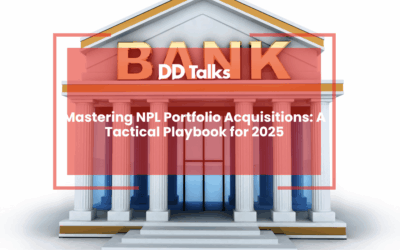Key Takeaways
- The European NPL market offers significant investment opportunities with approximately €300 billion in NPLs across European banks, with regional variations creating diverse entry points for investors.
- Successful NPL sourcing requires multiple channels including direct bank relationships, specialized brokers, asset management companies, and emerging digital platforms.
- A robust due diligence framework focusing on data integrity, loan documentation, collateral valuation, and borrower analysis is essential for mitigating investment risks.
- Effective NPL portfolio valuation combines discounted cash flow analysis, comparative transaction benchmarking, and statistical modeling with scenario testing to account for market volatility.
- Critical risk assessment must address legal, servicing capacity, data quality, macroeconomic, and reputational factors that can significantly impact returns.
- Different NPL asset classes (residential, commercial, corporate, unsecured consumer) require tailored investment strategies to maximize recovery potential.
- Developing clear investment criteria with defined return thresholds, portfolio composition guidelines, and operational feasibility assessments ensures disciplined decision-making in NPL investments.
Table of Contents
- Understanding the European NPL Market Landscape
- Key Sources for Finding NPL Investment Opportunities
- Developing a Robust NPL Due Diligence Framework
- How Do Successful Investors Value NPL Portfolios?
- Critical Risk Factors in NPL Investment Assessment
- Effective Screening Techniques for NPL Deal Selection
- Strategic Approaches for Different NPL Asset Classes
- Building Your NPL Investment Criteria Checklist
Understanding the European NPL Market Landscape
The European non-performing loan (NPL) market presents a complex yet potentially lucrative landscape for investors. With approximately €300 billion in NPLs across European banks as of 2023, understanding regional variations is crucial for successful market analysis. Southern European countries like Italy, Greece, and Spain continue to hold significant NPL volumes, while Central and Eastern European markets are emerging as new hotspots.
Market dynamics vary considerably across jurisdictions. Italy’s NPL market benefits from a well-established servicing infrastructure and GACS scheme, while Greece has accelerated NPL resolution through the Hercules Asset Protection Scheme. Spain’s market maturity offers competitive pricing but narrower margins. Meanwhile, emerging markets in Eastern Europe present higher-yield opportunities but with increased operational complexity.
Regulatory frameworks significantly impact NPL transactions, with the European Central Bank’s NPL guidelines pushing banks to reduce their non-performing exposures. The EU’s secondary market directive aims to harmonise NPL sales across member states, potentially opening new opportunities for cross-border investors. Understanding these regulatory nuances is essential for identifying market inefficiencies that create investment opportunities.
Current market trends indicate increased competition for prime NPL portfolios, driving investors toward specialised niches and alternative NPL-adjacent assets. The post-pandemic economic landscape has created new distressed debt categories, particularly in sectors heavily impacted by lockdowns and supply chain disruptions.
Key Sources for Finding NPL Investment Opportunities
Successful non-performing loan sourcing requires access to multiple channels and a strategic approach to opportunity identification. Direct bank relationships remain the cornerstone of NPL deal flow, particularly for larger investors. Building these relationships requires patience, credibility, and often a track record of successful transactions. Many European banks maintain preferred investor lists for their NPL disposals, making relationship cultivation essential.
Specialised NPL brokers and advisors serve as critical intermediaries, particularly for accessing mid-market opportunities. Firms like Deloitte, KPMG, and PwC frequently manage portfolio sales processes, while boutique advisors often have unique access to smaller, off-market transactions. Maintaining regular contact with these intermediaries ensures early notification of upcoming deals.
Asset management companies (AMCs) and national bad banks represent another significant source of NPL investment opportunities. Entities like SAREB in Spain, AMCO in Italy, and NAMA in Ireland periodically dispose of assets, often in structured transactions that can offer attractive entry points for investors with specific expertise.
Secondary market transactions—buying from previous NPL investors—have grown substantially as the European market has matured. These opportunities often arise when initial investors reach the end of their fund lifecycle or need to rebalance portfolios. Industry conferences, such as NPL Europe and SmithNovak events, provide valuable networking platforms for identifying these secondary opportunities and building relationships with potential sellers.
Digital platforms and marketplaces are emerging as innovative sources for NPL transactions, particularly for smaller portfolios. These platforms increase market transparency and can reduce transaction costs, making previously overlooked smaller portfolios economically viable investment targets.
Developing a Robust NPL Due Diligence Framework
A comprehensive NPL due diligence process forms the foundation of successful investment decisions. The framework should begin with data integrity verification, as NPL portfolios often suffer from incomplete or inconsistent information. Establishing data quality metrics and identifying critical gaps early allows investors to adjust valuation models accordingly or negotiate data remediation protocols with sellers.
Loan documentation review represents a critical component of the NPL due diligence process. This includes assessing the enforceability of security interests, identifying documentation deficiencies, and evaluating the completeness of credit files. In jurisdictions with complex foreclosure procedures, such as Italy or Greece, documentation gaps can significantly impact recovery timelines and costs.
Collateral valuation requires both desktop analysis and selective physical inspections. Modern approaches incorporate geospatial analytics and automated valuation models (AVMs) for residential properties, while commercial real estate typically demands more bespoke valuation methodologies. Understanding local market dynamics and liquidity factors is essential for accurate collateral assessment.
Borrower analysis should extend beyond financial metrics to include behavioural patterns and recovery potential. This may involve credit bureau data, litigation history, and assessment of strategic default indicators. For corporate borrowers, industry sector analysis and restructuring potential evaluation are crucial additional components.
Legal and regulatory due diligence must address jurisdiction-specific enforcement procedures, consumer protection regulations, and data protection requirements. The timeline for legal due diligence should align with exclusivity periods, focusing first on deal-breaker issues before proceeding to detailed analysis. Engaging local legal experts with specific NPL experience is invariably more efficient than using general banking lawyers.
How Do Successful Investors Value NPL Portfolios?
NPL portfolio pricing requires sophisticated valuation methodologies that balance analytical rigour with practical market insights. The foundation of most valuation approaches is discounted cash flow (DCF) analysis, which projects expected recoveries over time and discounts them to present value. Successful investors develop granular recovery curves based on historical performance data, adjusted for current market conditions and specific portfolio characteristics.
Comparative transaction analysis serves as an important complementary method, benchmarking potential acquisitions against recent comparable deals. Key metrics include price-to-gross-book-value ratios, price-to-market-value ratios for secured portfolios, and recovery multiples. However, these comparisons must account for portfolio composition differences, as seemingly similar portfolios can have dramatically different recovery profiles.
Statistical modelling and machine learning approaches are increasingly employed for large, granular portfolios. These techniques can identify recovery patterns and correlations not immediately apparent through traditional analysis. Leading investors maintain proprietary databases of historical performance to continuously refine their predictive models.
Scenario analysis and stress testing are essential for robust valuation, particularly in volatile economic environments. Investors typically model base, upside, and downside scenarios, with particular attention to macroeconomic factors like property market trends, interest rate movements, and unemployment rates that directly impact recovery outcomes.
Servicing strategy and costs significantly impact portfolio returns and must be integrated into valuation models. Different servicing approaches—from legal enforcement to consensual restructuring—yield varying recovery profiles and operational expenses. The most sophisticated investors model multiple servicing strategies for each loan segment to optimise the overall approach.
Critical Risk Factors in NPL Investment Assessment
NPL risk assessment requires systematic identification and quantification of multiple risk dimensions. Legal and regulatory risks stand at the forefront, particularly in jurisdictions with evolving foreclosure frameworks or debtor protection measures. Recent legislative changes in countries like Greece, Italy, and Spain have significantly altered recovery timelines and processes. Investors must monitor pending legislation that could impact enforcement procedures or borrower rights.
Servicing capacity risks can severely impact portfolio performance. The availability of quality servicers varies significantly across European markets, with some regions facing capacity constraints that can delay implementation of recovery strategies. Investors should assess servicer track records, operational capabilities, and potential conflicts of interest, particularly when servicers manage portfolios for multiple competing investors.
Data quality risks often remain underappreciated until post-acquisition. Missing documentation, inaccurate collateral information, or incomplete borrower data can materially impact recovery outcomes. Leading investors develop data quality scoring methodologies to quantify these risks and incorporate them into pricing models.
Macroeconomic and market liquidity risks directly affect both recovery amounts and timelines. Property market dynamics particularly impact secured NPLs, with regional variations in liquidity potentially creating significant performance disparities within a single portfolio. Sophisticated investors develop granular market monitoring frameworks that track liquidity indicators at regional and even neighbourhood levels.
Reputational risks have gained prominence as investors face increased scrutiny regarding borrower treatment practices. Regulatory focus on fair treatment of vulnerable borrowers requires investors to implement appropriate governance frameworks and borrower engagement protocols. This is particularly relevant in consumer NPL portfolios, where aggressive collection practices can trigger regulatory intervention and reputational damage.
Effective Screening Techniques for NPL Deal Selection
Efficient NPL deal screening enables investors to quickly identify promising opportunities and avoid misallocating resources to unsuitable transactions. Initial portfolio stratification represents the first critical screening step, segmenting loans by collateral type, borrower category, vintage, and performance status. This stratification reveals portfolio composition and helps identify segments that align with investor expertise or present particular challenges.
Preliminary data analysis should focus on key performance indicators that can be quickly assessed, such as weighted average loan-to-value ratios, collateral concentration, and borrower type distribution. Red flag identification systems help spot potential deal-breakers early, including significant documentation gaps, legal impediments to enforcement, or concentration risks that exceed investor parameters.
Competitive positioning assessment is essential in increasingly crowded NPL markets. Investors should evaluate their comparative advantages for each opportunity, whether through servicing capabilities, local market knowledge, or synergies with existing portfolios. This assessment helps prioritise opportunities where the investor can realistically outcompete others, rather than pursuing transactions where pricing is likely to be driven beyond rational levels.
Resource allocation frameworks ensure that due diligence efforts align with transaction potential. Many successful investors implement staged approval processes with clearly defined criteria for advancing opportunities through the pipeline. This might include preliminary approval thresholds based on expected returns, portfolio size, and strategic fit before committing significant due diligence resources.
Seller motivation analysis provides valuable context for deal screening. Understanding whether a sale is driven by regulatory pressure, capital optimisation, or strategic refocusing can inform negotiation strategies and reveal potential flexibility on terms. Experienced investors develop relationships that provide insights into seller priorities beyond the formal sale process.
Strategic Approaches for Different NPL Asset Classes
Different NPL asset classes demand tailored investment strategies to maximise returns. Residential mortgage NPLs typically offer more predictable recovery patterns but narrower margins in mature markets. Successful strategies often involve standardised workout approaches with selective legal enforcement, combined with refinancing options for cooperative borrowers. Scale advantages are significant in this segment, as process automation can substantially reduce per-loan servicing costs.
Commercial real estate NPLs present higher complexity but potentially greater upside. Effective strategies require deeper real estate expertise and often involve active asset management to enhance collateral value before exit. Investors increasingly adopt a “loan-to-own” approach for prime assets, deliberately pursuing foreclosure to capture property upside potential through repositioning or redevelopment.
Corporate and SME NPLs demand more bespoke approaches focused on business viability assessment and restructuring expertise. Successful investors in this segment typically combine financial restructuring capabilities with operational turnaround experience. The strategy often involves engaging with borrowers to implement sustainable debt structures while improving business performance, potentially including debt-to-equity conversions for viable enterprises.
Unsecured consumer NPLs require sophisticated data analytics and collection optimisation. The strategy typically revolves around borrower segmentation based on payment probability, with tailored approaches ranging from settlement offers to legal enforcement. Regulatory compliance is particularly critical in this segment, with increasing scrutiny of collection practices across European jurisdictions.
Mixed portfolios, which combine multiple asset classes, present both challenges and opportunities. While they require diverse expertise, they often face less competitive pressure in the market. Successful investors develop modular servicing approaches that apply specialised strategies to each segment while maintaining overall portfolio cohesion. Some investors deliberately target these mixed portfolios, planning to optimise each segment separately and potentially divest certain components to specialists.
Building Your NPL Investment Criteria Checklist
Developing clear NPL investment criteria provides a structured framework for consistent decision-making. Return threshold parameters should be explicitly defined, with minimum IRR and cash-on-cash multiple requirements that reflect the risk profile of different NPL categories. These thresholds should incorporate risk premiums for factors like jurisdiction complexity, data quality issues, and servicing challenges.
Portfolio composition guidelines help maintain strategic focus and risk management discipline. These might include maximum exposure limits for specific regions, collateral types, or borrower categories. Many investors establish concentration limits to avoid overexposure to particular market segments or risk factors. These guidelines should align with the investor’s expertise and competitive advantages.
Operational feasibility assessment criteria ensure that investment decisions account for implementation challenges. This includes evaluating servicer availability, data migration complexity, and regulatory requirements. Experienced investors develop operational readiness checklists that must be satisfied before transaction approval, preventing investments that cannot be effectively managed post-acquisition.
Exit strategy clarity is essential for NPL investments, with defined time horizons and liquidity expectations. Each potential investment should have multiple identified exit options, whether through individual loan resolutions, portfolio refinancing, or secondary market sales. The criteria should specify minimum expected liquidity profiles and maximum acceptable recovery timelines.
Ethical and reputational considerations have become increasingly important components of NPL investment criteria. These include borrower treatment standards, particularly for vulnerable customers, and environmental, social, and governance (ESG) factors. Leading investors develop formal responsible investment policies specific to NPL acquisitions, recognising that reputational risks can materially impact long-term returns.
Regular criteria review processes ensure that investment parameters remain aligned with market conditions and organisational capabilities. Many successful investors conduct quarterly reviews of their criteria, incorporating lessons from recent transactions and adjusting thresholds based on market evolution. This disciplined approach to criteria refinement helps maintain competitive positioning while managing risk exposure effectively.
Frequently Asked Questions
What are the current trends in the European NPL market?
The European NPL market is experiencing increased competition for prime portfolios, pushing investors toward specialized niches. Southern European countries (Italy, Greece, Spain) maintain significant NPL volumes, while Central and Eastern European markets are emerging as new hotspots. Regulatory frameworks like the ECB’s NPL guidelines and the EU’s secondary market directive are harmonizing practices across member states. Post-pandemic economic conditions have created new distressed debt categories, particularly in sectors heavily impacted by lockdowns and supply chain disruptions.
How do investors source NPL investment opportunities?
Investors source NPL opportunities through multiple channels: direct bank relationships, specialized brokers and advisors (Deloitte, KPMG, PwC), asset management companies (SAREB, AMCO, NAMA), secondary market transactions from previous NPL investors, industry conferences and networking events, and emerging digital platforms and marketplaces. Building credible relationships with banks and intermediaries is essential for accessing quality deal flow, particularly for off-market transactions.
What valuation methodologies are used for NPL portfolios?
Successful NPL portfolio valuation combines several methodologies: discounted cash flow (DCF) analysis projecting expected recoveries over time, comparative transaction analysis benchmarking against recent similar deals, statistical modeling and machine learning for large portfolios, scenario analysis and stress testing to account for market volatility, and servicing strategy modeling that incorporates different approaches and their associated costs. The most sophisticated investors maintain proprietary databases of historical performance to refine their predictive models.
What are the main risk factors in NPL investments?
Critical NPL investment risks include: legal and regulatory risks from evolving foreclosure frameworks, servicing capacity constraints in certain markets, data quality issues like missing documentation or inaccurate collateral information, macroeconomic and market liquidity risks affecting recovery amounts and timelines, and reputational risks related to borrower treatment practices. Successful investors develop systematic frameworks to identify, quantify and mitigate these risks throughout the investment lifecycle.
How do investment strategies differ across NPL asset classes?
Different NPL asset classes require tailored strategies: residential mortgage NPLs benefit from standardized workout approaches with selective enforcement; commercial real estate NPLs often involve active asset management to enhance collateral value; corporate and SME NPLs demand business viability assessment and restructuring expertise; unsecured consumer NPLs require sophisticated data analytics and collection optimization; and mixed portfolios need modular servicing approaches that apply specialized strategies to each segment while maintaining overall portfolio cohesion.
What should be included in NPL investment criteria?
A comprehensive NPL investment criteria checklist should include: clear return threshold parameters (minimum IRR and cash-on-cash multiples), portfolio composition guidelines with concentration limits, operational feasibility assessment criteria, exit strategy clarity with defined time horizons, ethical and reputational considerations including borrower treatment standards, and a regular review process to ensure criteria remain aligned with market conditions. These parameters should reflect the investor’s expertise, competitive advantages, and risk tolerance.
How important is due diligence in NPL investments?
Due diligence is fundamental to successful NPL investing. A robust framework includes data integrity verification to identify gaps and inconsistencies, comprehensive loan documentation review to assess enforceability, collateral valuation combining desktop analysis with selective physical inspections, borrower analysis extending beyond financial metrics to behavioral patterns, and jurisdiction-specific legal and regulatory assessment. The due diligence process should be structured to identify deal-breakers early before committing significant resources to detailed analysis.




0 Comments